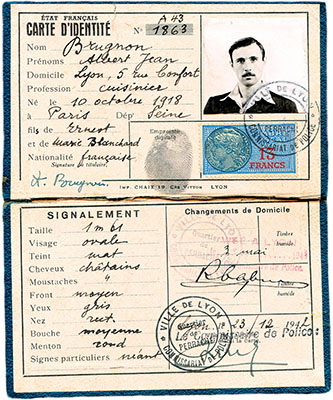The cover story had to explain why a military-age civilian man was either not being held as a prisoner of war or being used as a laborer by the Germans. 2LT Brucker was to become “Albert Jean Brugnon.”4 Brucker was told to treat his new alias as “private and confidential.”5 Albert (close to his own name, Herbert) Brugnon was born in Paris on 10 October 1918. Since his father was killed in the First World War, his mother, a cook, raised him. Brugnon learned to cook from his mother and worked in that profession until 1939. In that year, he was called up for service in the French Army. He was captured by the Germans when they invaded France in mid-1940. While interned in a German Prisoner of War (POW) camp, Stalag XVII-B at Krebs, Austria, he developed a gastric ulcer (there was no easy way to verify this medical condition). After being repatriated and demobilized on 7 December 1942 at Lyon, France, Brugnon found employment as a cook.6 Although he had several close calls, Brucker, alias Brugnon, had a successful mission despite some problems with his cover and documentation.
2LT Brucker jumped into rural France in St. Viatre on 28 May 1944 wearing a three-piece wool business suit. Neither he, nor the OSS realized, that the average French worker in the country only owned one suit for church or funerals. Brucker had to scramble to get denim clothing like that worn by the local farmers. Another problem was that his OSS-issued ration cards were out of date and on the wrong colored paper. Despite careful preparation on the part of the OSS forgers, they could not keep up with changing conditions on the ground. Seemingly minor slip-ups could easily have proven fatal.7
The closest that Brucker came to being captured was when he and his French bodyguard, Raymond Compain, inadvertently “bumped into” a 30-man German checkpoint. Coming around a blind corner on their tandem bicycle, the two were surprised when three German guards stopped them. While the two got out their papers, the Germans patted Compain down and felt the hard outline of his concealed pistol. Compaign grabbed the rifle muzzle of the first enemy soldier and the pistol of the second. Responding rapidly, Brucker pulled out his .32 Colt automatic pistol, shot the third German and then those wrestling with Compain. The pair fled before the rest of the German platoon could react. Brucker was awarded the Distinguished Service Cross for his valor in enemy-occupied France.8

